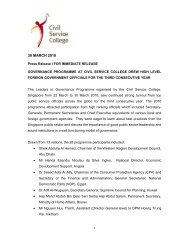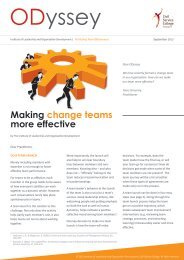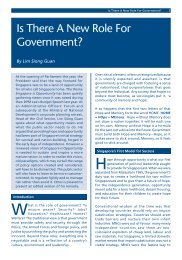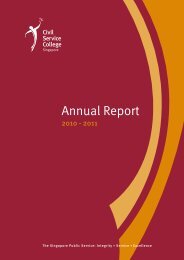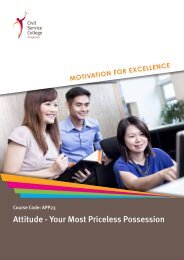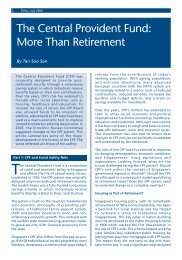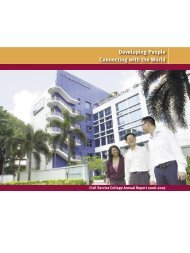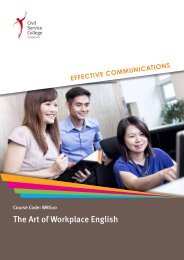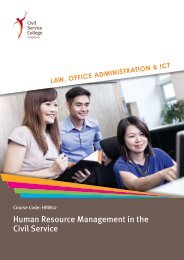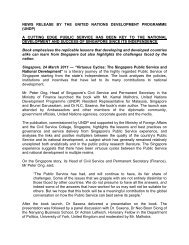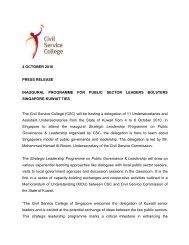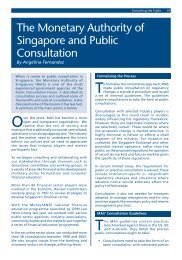Public Consultation Toolkit - Civil Service College
Public Consultation Toolkit - Civil Service College
Public Consultation Toolkit - Civil Service College
Create successful ePaper yourself
Turn your PDF publications into a flip-book with our unique Google optimized e-Paper software.
<strong>Public</strong> <strong>Consultation</strong> <strong>Toolkit</strong> 45 46 <strong>Public</strong> <strong>Consultation</strong> <strong>Toolkit</strong><br />
Case 12:<br />
Penal Code (Amendment) Bill<br />
Agency/country:<br />
• Ministry of Home Affairs (MHA), Singapore<br />
Background:<br />
• MHA reviewed and proposed amendments to the Penal Code in 2007. As the Penal Code had<br />
a wide ranging impact on society, extensive public consultation was conducted to gather<br />
feedback and assess public sentiment.<br />
<strong>Consultation</strong> Process:<br />
• MHA posted the Amendment Bill on REACH’s Portal for the public to give their feedback and<br />
views.<br />
• MHA was explicit about the scope of influence; members of the public were invited to<br />
provide feedback for either one or all the amendments to the Penal Code.<br />
• To ensure participants had a clear context and background of the information a summary<br />
of the amendments to the Penal Code was provided in the e-portal of REACH to provide an<br />
explanation on the amendments. Presentations on the amendments were also delivered<br />
during the focus groups to prepare participants for the discussion.<br />
• MHA partnered REACH to post the Amendment Bill on REACH’s Portal for the public to give<br />
their feedback and views. A news release was also issued to inform members of the public on<br />
the consultation exercise.<br />
• MHA also worked with REACH to identify facilitators to conduct focus groups, and<br />
stakeholders to participate in them.<br />
• Feedback was sought from people from different walks of life, e.g., religious groups, voluntary<br />
welfare organisations (VWOs), students, grassroots members, social workers.<br />
• A women-only focus group was also set up to discuss the proposals, particularly those which<br />
concerned marital immunity which impacted them directly.<br />
• MHA also sought feedback from the Law Society on the proposed amendments.<br />
• MHA was upfront that the consultation would be over a period of five months.<br />
• REACH assisted MHA in monitoring feedback received over the e-portal and collated the<br />
feedback for MHA’s attention. MHA also actively monitored and collated feedback received<br />
from other channels such as feedback posted in the media, Law Society and focus groups for<br />
evaluation.<br />
Outcomes:<br />
• MHA evaluated the feedback received and incorporated some of the suggestions into the<br />
Bill.<br />
• The feedback was acknowledged in the Second Reading Speech in Parliament.<br />
7. Follow-up and analysis<br />
Closing the loop is a vital step in the public consultation process. After being consulted, the<br />
public will expect to know the outcome. Hence, after the consultation period ends, agencies are<br />
encouraged to follow up on:<br />
• Collating the feedback and closing the loop with stakeholders; and<br />
• Assessing the effectiveness of the consultation exercise and identifying areas for<br />
improvement.<br />
7.1. Step 8: Collate feedback and close the loop<br />
After the feedback is received from the participants, agencies need to collate the feedback to<br />
identify the common themes and important issues. Agencies should consolidate and categorise<br />
the feedback and data received and document the findings in a report.<br />
The report should contain the following information:<br />
• Number of participants;<br />
• Timeframe of the consultation exercise;<br />
• <strong>Consultation</strong> process (channels, feedback mechanisms);<br />
• Feedback received (categorised);<br />
• Explanation for accepting or rejecting each category<br />
of feedback; and<br />
• Limits of the consultation approach.<br />
In addition, agencies need to demonstrate that they recognise<br />
and acknowledge the contributions of participants and assure<br />
participants that their feedback has been taken into<br />
consideration. This will also serve to encourage further<br />
involvement in public consultation exercises in the future.<br />
“... a common grouse<br />
of the public who are<br />
unhappy with the<br />
government’s public<br />
consultation process is<br />
the oft quoted officious<br />
and non-committal<br />
replies they receive. Whilst<br />
they do not expect the<br />
government to agree to<br />
or accept every feedback<br />
and suggestion, they do<br />
expect the government<br />
to adequately address<br />
their concerns and explain<br />
the rationale for the<br />
decisions.”<br />
– Dr Amy Khor,<br />
Chairman REACH



